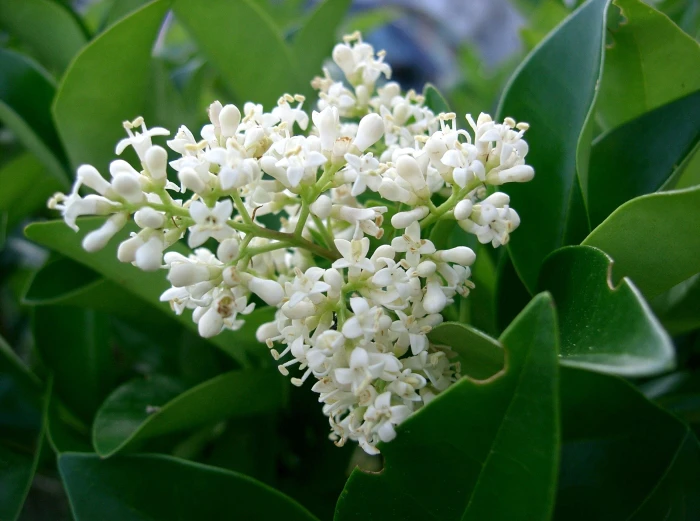Japanese Privet
(Ligustrum japonicum)
Japanese Privet (Ligustrum japonicum)
/
/

KENPEI
CC BY-SA 3.0
Image By:
KENPEI
Recorded By:
Copyright:
CC BY-SA 3.0
Copyright Notice:
Photo by: KENPEI | License Type: CC BY-SA 3.0 | License URL: http://creativecommons.org/licenses/by-sa/3.0/ | Uploader: KENPEI | Publisher: Wikimedia Commons | Title: Ligustrum_japonicum_04.jpg | Notes: |




























Estimated Native Range
Climate Requirements for Grants Pass, Oregon
| This Plant | Your Site | Plant Suitability for Your Location | ||
|---|---|---|---|---|
| • Precipitation | 8" - 170" | 33" | Your precipitation may be insufficient for this plant. Irrigate N" / year. | Irrigate N" / year |
| • High Temp. | 64°F - 107°F | 90°F | Your summer temperatures are normal for this plant. | Excellent |
| • Low Temp. | -22°F - 69°F | 33°F | Your winter temperatures are normal for this plant | Excellent |
This plant should grow well at your location with about N inches per year (Y minutes per month) of irrigation.
Summary
Ligustrum japonicum, commonly known as Japanese Privet, is an evergreen tree or shrub native to various habitats including marshes, forests, and deserts in East Asia, specifically regions of Japan, Korea, and surrounding islands. It typically grows to a height of 2–5 meters, occasionally reaching up to 6 meters, and features smooth, pale grey-brown bark on its stems. The plant was introduced to North America in the early 19th century and has since become invasive, particularly in the southern United States.
Japanese Privet is occasionally cultivated as an ornamental plant in Europe and North America, with several garden cultivars such as ’Rotundifolium’, characterized by its broad leaves, and ’Silver Star’, notable for its creamy-white leaf margins. It produces white flowers in the spring and summer seasons. In terms of cultivation, it thrives best in full sun or part shade, requires low amounts of water, and can adapt to soils with varying drainage speeds, from fast to slow. However, it’s important to note that Ligustrum japonicum is potentially invasive outside its native range, including in the United States, and should be grown with caution.CC BY-SA 4.0
Japanese Privet is occasionally cultivated as an ornamental plant in Europe and North America, with several garden cultivars such as ’Rotundifolium’, characterized by its broad leaves, and ’Silver Star’, notable for its creamy-white leaf margins. It produces white flowers in the spring and summer seasons. In terms of cultivation, it thrives best in full sun or part shade, requires low amounts of water, and can adapt to soils with varying drainage speeds, from fast to slow. However, it’s important to note that Ligustrum japonicum is potentially invasive outside its native range, including in the United States, and should be grown with caution.CC BY-SA 4.0
Plant Description
- Plant Type: Tree, Shrub
- Height: 6-10 feet
- Width: 6-8 feet
- Growth Rate: Rapid
- Flower Color: White
- Flowering Season: Summer, Spring
- Leaf Retention: Evergreen
Growth Requirements
- Sun: Full Sun, Part Shade
- Water: Low
- Drainage: Fast, Medium, Slow
Common Uses
Bee Garden, Bird Garden, Border Plant, Butterfly Garden, Deer Resistant, Drought Tolerant, Fragrant, Hedges, Potted Plant, Salt Tolerant, Showy Flowers, Street Planting
Natural Habitat
Floodplain forests, wetlands and pine flatwoods
Other Names
Common Names: Japanese Wax-Leaf Privet , Wax-Leaf Privet , Japanse Liguster , 광나무
Scientific Names: Ligustrum japonicum , Ligustrum japonicum var. coriaceum , Ligustrum rotundifolium , Ligustrum coriaceum , Ligustrum japonicum var. rotundifolium , Ligustrum amamianum , Ligustrum japonicum var. pubescens , Ligustrum japonicum f. pubescens , Ligustrum latifolium , Ligustrum japonicum var. spathulatum
GBIF Accepted Name: Ligustrum japonicum Thunb.